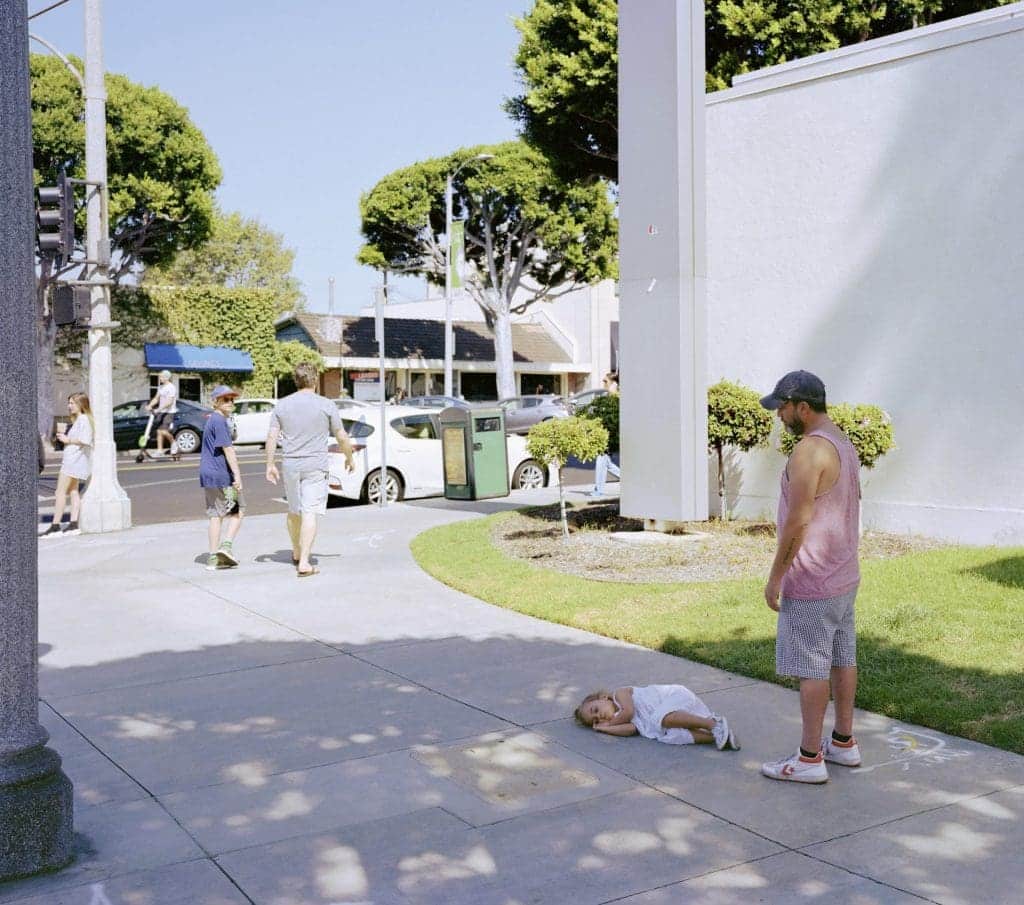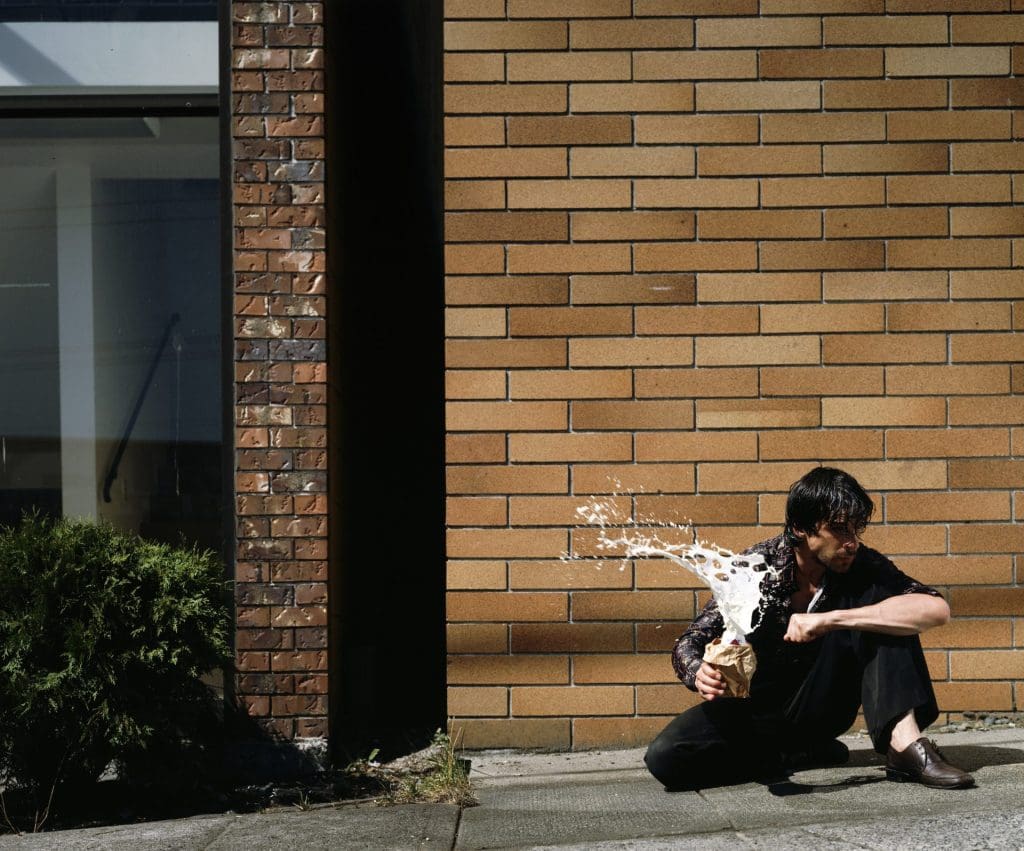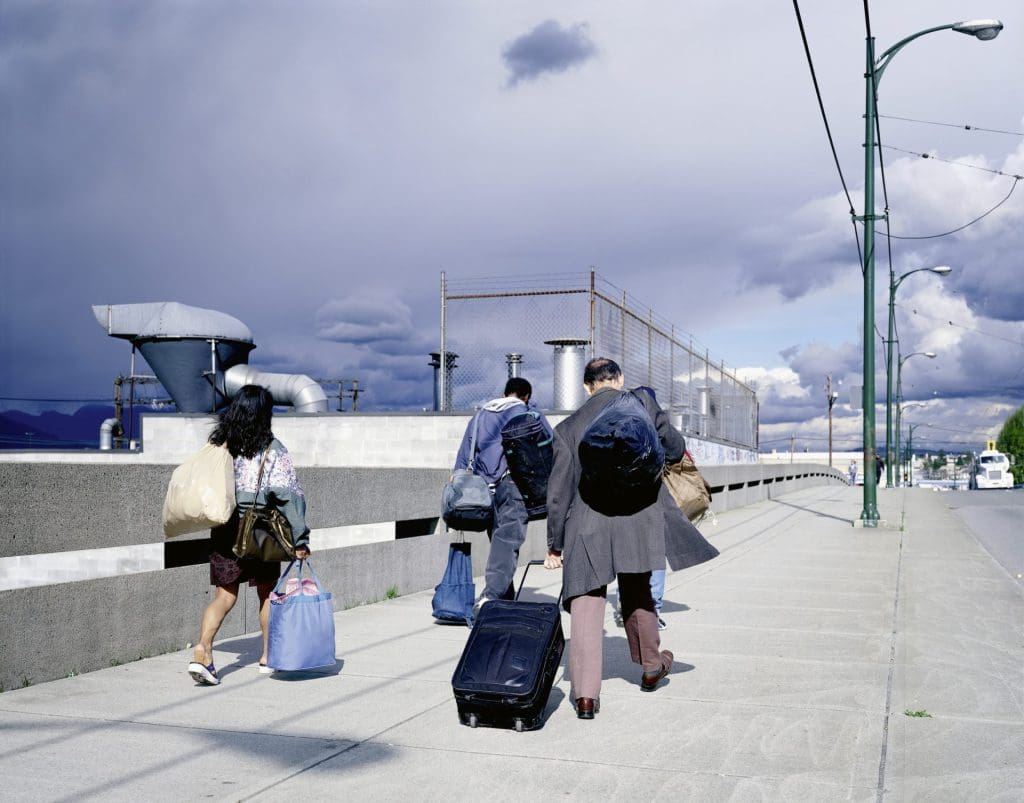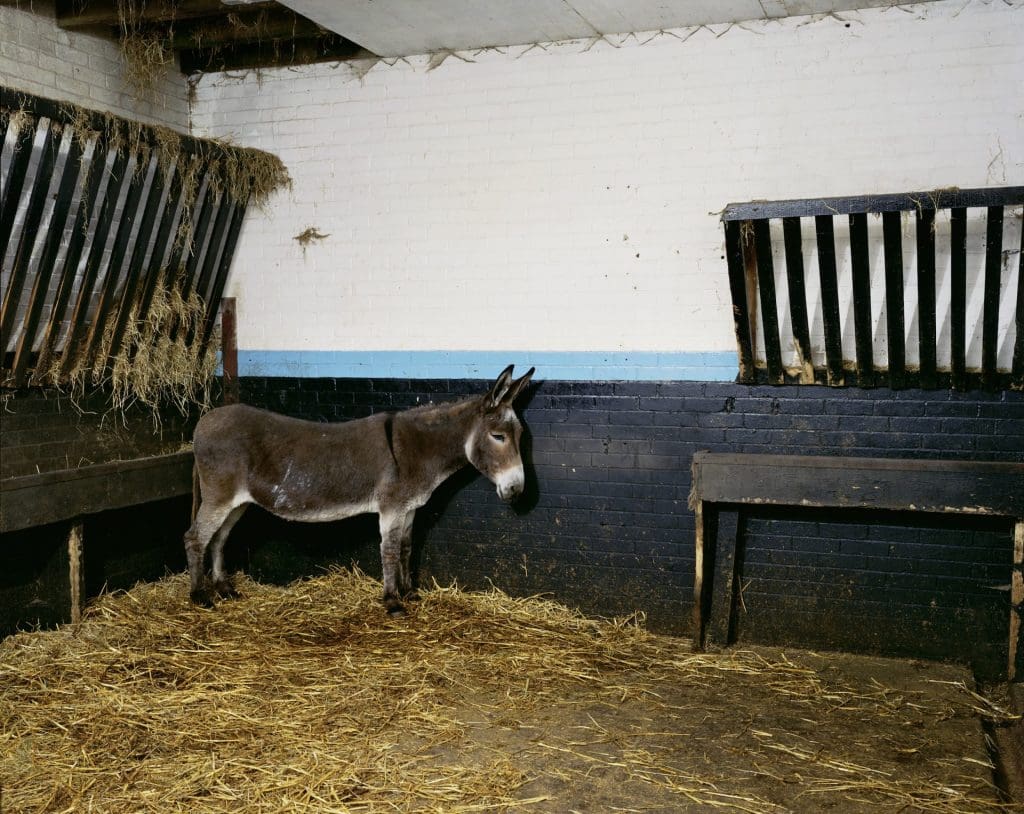
In the 1980s, the work of artist Jeff Wall was first compared to that of Charles Baudelaire. Whilst at first linking a contemporary photographer from Vancouver to a 19th-century Parisian poet seems somewhat strange, what links them is their status as documenters of modern life. They are non-partisan, detached observers who watch the world – fleeting, ephemeral, banal, marvellous – go by.
Yet Wall is no street photographer. Whilst rooted in reality, his images are rigorously composed and staged, inflected with a touch of the uncanny. Milk (1984) depicts a man sitting strangely on a pavement, seemingly oblivious as his titular beverage sprays in the air. Overpass (2001) shows three people in an industrial landscape walking with suitcases away from the camera. Morning Cleaning, Mies van der Rohe Foundation, Barcelona (1999), shows a man mopping the floor of a luxurious building – his back turned away from the gorgeous sunlight on the marble wall. In An Eviction (1988/2004) is a wide perspective image depicting an ordinary suburban street. A bust-up between cops and tenants is the focal point of pedestrian gazes, but appears as small in the frame as the central action in Pieter Breughel’s Landscape with the Fall of Icarus (c.1560).
A constellation of art historical references find their way into Wall’s work: Auguste Rodin, Edouard Manet, Katushika Hokusi and Albert Durer are all referenced. Yet their poses and compositions are transposed into contemporary global settings: impoverished and wealthy, intimate and public. On the occasion of a retrospective of Wall’s work at the Fondation Beyler in Switzerland, A RABBIT’S FOOT speaks to the photographer about the importance of cinema in his work, his opinion on A.I. and creating images that speak to everyone.
You describe your work as ‘cinematographic’ – in what ways is your photography inspired by cinema?
A long time ago, I began to use the term cinematography for what I do. Not because I wanted to be a filmmaker or to create cinematic effects in a still form (as my work has sometimes been interpreted), but because I was increasingly impressed by the artistry and technical range of how photography was practiced in the making of films. Films can be made with so many inventive, elaborate ways of doing things. And photographers in the classic tradition – which was still pretty dominant in the 1970s – were basing themselves on photojournalism, which meant minimal equipment. But even though it was a more accepted one, it wasn’t the only way to do photography. I was drawn to other possibilities for photography, and the most sophisticated ones were the ones that cinematographers had developed. So I basically just adapted those techniques to still pictures.

Inkjet print, 224 x 254 cm Courtesy of White Cube
© Jeff Wall
And to name names… were there any specific directors or cinematographers that you were drawn to or inspired by?
All the good ones! We’re talking about a certain moment when I was trying to do this. So there were the prominent models or exemplars of the time – like in the 1970s it was all the heroes of auteurism. Like [François] Truffaut or [Ingmar] Bergman and so on. And if you look at their films, you can see the great photography in them. And those photographs were made by people like Sven Nykvist. Those guys were great photographers and they also displayed that invention, which I found so impressive. I also found it opened doors for things I wanted to do. So instead of having to, in a sense, reinvent the wheel, I could simply transpose over from my experience of film. I didn’t want to transpose them over from commercial photography, which of course also uses a lot of artifice. The results of some famous fashion photographer or commercial photographer just weren’t interesting artistically.
There’s an interesting tension between the still and moving image, then. I’m sure if you had wanted to be a cinematographer, you would have become a cinematographer… But it’s kind of inherent to what you’re doing that the image is still.
I wanted to exclude as strongly as possible any sense that it had an unrealized cinematic aspect. I don’t want that in my work. I want it to be resolutely still photography.
I wondered if you could talk more about your work A Sudden Gust of Wind (after Hokusai), which also plays with a certain tension between stillness and movement.
One day I was in a bookstore and opened a book on [the Japanese artist] Hokusai. I don’t remember having seen that image before and it struck me how photographic it was – capturing that instant when the papers blew out of a person’s folder into the air. I thought it was just so open to being photographically reworked and it coincided with the beginning of the ability to do digital montage which only really became a possibility by about 1991. If I hadn’t had those means, of course I would never have done it. So I just set about using that new technology. The only way it was ever going to be possible was artificially. And so it was an interesting experiment using what was still pretty new means, and even though it was rather laborious, it was within the range of what could be accomplished. I thought it would be fascinating to see how divergent mine would be. The Hokusai print was part of a series of views onto Mount Fuji. It wasn’t necessarily about some incident on a path with papers.

Transparency in lightbox, 187 x 229 cm Collection FRAC Champagne-Ardenne, Reims © Jeff Wall

Transparency in lightbox, 214 x 273.5 cm
Emanuel Hoffmann Foundation, on permanent loan to the Öffentliche Kunstsammlung Basel
© Jeff Wall
I was speaking to a photographer recently who uses a lot of graphics and AI and CGI in her work. And she thought that there’s a tendency in photography today to be so in pursuit of truth and reality, that it kind of becomes sort of anti-intellectual. Do you see this pursuit of truth as limiting?
No. I think they’re right that photography has a unique relationship to the so- called truth, because it’s the first technology that could automatically record the appearance of things without any distortion. That element of photography is permanent and we will not escape it.
If you told an artificial intelligence program to make an oak tree, it would scour the available image bank, which is gigantic but finite, and come up with some sort of composite, probably perfectly acceptable tree. But that’s not what I’m going to see this afternoon when I go outside and the sun hits a tree in a certain way. The tree that the AI creates is the tree that has already existed. So I would say that people who are overly excited about recycling endless images are maybe forgetting something pretty important about what images do.

Lightjet print, 226 x 305.3 cm
Emanuel Hoffmann Foundation, gift from the President 2012, on permanent loan to the Öffentliche Kunstsammlung Basel
© Jeff Wall

Transparency in lightbox, 195 x 244 cm
Kunstmuseum Basel, acquired with the Government Purchase Loan and a contribution from the Max Geldner Foundation in 2001
© Jeff Wall
There’s such a wide variety of subjects and themes and locations and people that you’re shooting… do you think there are messages or symbols in them that only you would recognize?
Every time I get excited about something, it’s not because of my own unique relationship to it. I like to feel that they will interest pretty much anyone. For example, I did a picture of a boy falling out of a tree in his backyard on a beautiful summer evening. I fell out of a tree as a kid, and I broke my arm and so on. And the picture did emerge from that memory coming back to me for some reason. But I didn’t do it because I fell out of a tree, really. I did it because the subject seemed to be really compelling. The fall, gravity. Everybody is subject to gravity. So it just seemed like a subject that everyone could relate to. That creates an openness in the picture to all the responses of other people. Which are going to be somewhat different from mine. Certain subjects are inspiring because they have that quality. They don’t require anybody to know anything special.
You also often reference the specific social context of Northern America and the Western world, with particular signifiers of wealth and poverty.
Photography can only be done specifically. You can’t photograph in general. So everything is set in actuality. I hope that these actualities aren’t so desperately specific that someone in a faraway place can’t hook onto them. So if you see a picture of, let’s say, some people walking in Vancouver, carrying their bags because they have nowhere to go, if it was exhibited in Thailand, it might also be easy to connect to. I like to think that pictures themselves have a certain openness that people can relate to even though they’re showing something foreign.

Transparency in lightbox, 187 x 351 cm
Kunstsammlung Nordrhein-Westfalen, Düsseldorf. Purchased 2000 with assistance of the Ernst von Siemens-Kunstfond
© Jeff Wall

Two lightjet prints; left: 183 x 212.4 cm, right: 200 x 250.5 cm
The George Economou Collection
© Jeff Wall
And as a photographer, are you constantly moving around and looking for these images, or is it more of a passive search?
Luckily for me, I decided a long time ago that I wasn’t going to just go hunting. I wasn’t going to be that kind of photographer. I wanted to have the same kind of artistic freedom that a poet could have, or a painter or a composer of music, that they could literally lie on the sofa for a week and come up with something so I don’t have to do any one thing. The Hokusai picture emerged from a chance occurrence. And other pictures I’ve done have come from memories that came back or things I read or something like that. Even just things that emerge from literal daydreams. So I do hunt when I feel like it, or when I get the sense there’s something to hunt for, but I don’t have to because there’s no single starting point.
Your work obviously lives in other forms, in books and online and so on. What is the importance of the exhibition context?
I was talking to somebody just yesterday, exhibition, and he was mentioning one of the pictures which shows a woman who’s a kind of a nurse’s aide, carrying a tray covered with a towel or cloth, and she’s taking it along a path somewhere. And he said, I noticed that she has a hair net on and he said that was really striking. It reinforced the fact that, as far as I’m concerned, you need to see my pictures hanging on the wall in front of you. That’s when you really see them. They’re made the size they are for specific reasons. And when you see it on your phone, you aren’t seeing it. You’re seeing a little iconic report on what it vaguely looks like, and you’re not experiencing what I do at all. And I don’t think my pictures really come across in reproduction on pages, even, of books. They just are the kind of account of the general appearance. To be seen as they are, you need to be there.
‘Jeff Wall’ is on at Fondation Beyeler until 21st April
www.fondationbeyeler.ch





